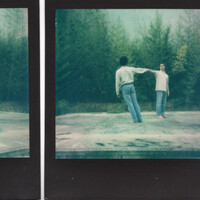Wed 14 Jun: ALLOUAQUI DANCE THEATRE/ ATTILA ANDRASI/ NICOLA ADILMAN
News Story
AllouAqui Dance TheatreKOKONA
Attila AndrasiOnce Upon a Time
Nicola AdilmanPlay by Play
“Again!”. The dancer repeated her introduction. “Again!”. Everytime she exaggerates her speech to the point of absurdity. “Again!”, the man continued to command, building the tension between the pair. Tension which spills over into a duet of locked heads, sensual partnerwork, and hairography. Their sustained confidence in breaking the fourth wall reminded me that despite being an audience member, I could also be observed. Kokono was described in our programs as an exploration of the artist's experienced femininity. While this rang true, the dancer’s attempts to enforce their ideals and desires upon each other piqued my curiosity. The duet was seasoned with succinct speech that effectively communicated these ideas without distracting from the piece’s visual landscape.
Entering for the second work of the evening, we were greeted with a red football that would become the central focus of a solo. The minute articulations of Attila Andrasi's limbs, and especially feet, saw him glide across the stage. The solo played on the divide of childhood and adulthood to induce a yearning for the years of growing up. His child-like movements portrayed a timid persona which felt more developed than other moments within the choreography. A game of catch between the audience and Andrasi was a fitting conclusion to the work.
Play By Play finished off the evening by portraying a perspective of the sporting world that magnified its quirks and performative nature. Motifs from various sports were subtly sprinkled throughout the choreography which demanded exciting athleticism and explosive dynamics. The opening scene quickly implanted the theme into the viewer's mind as we saw the dancers switch between the challenging movement and comically exaggerated victory celebrations. All while being serenaded by the audio of sport commentators. Play by Play’s colourful unisex outfits blurred the boundaries of gender and were a challenge to sports obsession with the binary.
Dynamic duo Delicia Sefiha and Xavier De Santos investigate the tricky terrain of performative femininity in Kokona. Each test out codes of movement associated with the concept and although their enactments bring nothing new to the topic, they are hilarious: the over-sexualised object, a nose picking, burping ladette, or a roaring, macho woman. My favourite sequence displays the similarly dressed pair struggling to become one body. Entangled around each other in a wrestling, groping tango duet and lost in each other’s long hair, they bring an unconventional partnering to the tango. There are too many ideas for this short piece to unpack, yet the dancers and particularly their hair choreography are impressive.
When it’s not on us, Attila Andrasi’s intense focus rests on a red football centre stage. A symbol of his childhood, it means more to him than we can imagine. Andrasi dedicates his luscious moves to this object as he transitions between different, emotionally charged choreographic states. At first, in serious somatic practitioner mode, he follows complex linear pathways, that both disconnect and reconnect him to the ball. But the object inspires a lighter side too as his liquid, virtuosic practice morphs into a deliciously camp disco dance. Playfully throwing the ball to members of the audience, Andrasi further forges his strong connection with us making him a compelling dancer to watch.
The riveting facial expressions of the four dancers in Nicola Adilman’s quartet as they mime and gesture to a football commentary have me in stitches. Collectively they embody the full range of emotions that belong to the world of male footballers: ecstasy, despair, anger and cockiness. However as the performers dance across their unique sporty playing fields in their vividly bright costumes, they refreshingly erase gender differences. Athletic choreography performed in a colourful huddle or solo character sketches make Play by Play exhilarating to watch, especially in the round. Character, strength and stamina ooze from the group’s high energy dancing, making Play by Play a winner.
Josephine Leask


